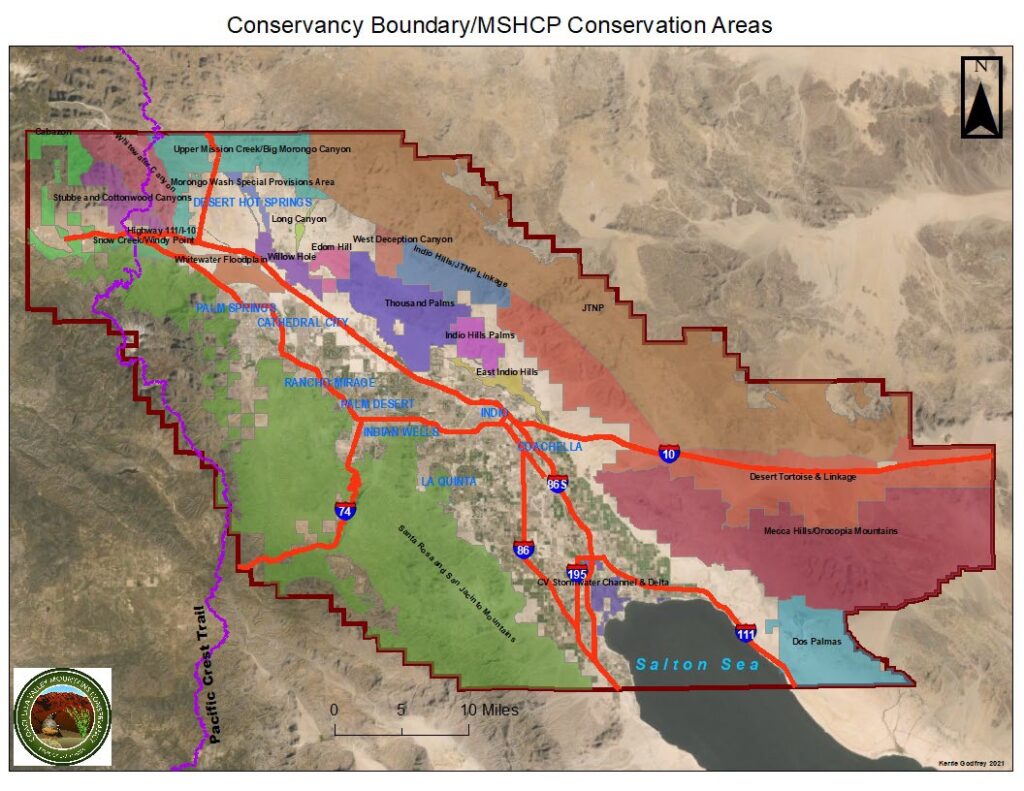Coachella Valley Mountains Conservancy Acquisition Priorities
The Conservancy’s mission under state law is to protect lands with “open-space, wildlife, scenic, environmental, anthropological, cultural, scientific, educational and recreational resources”, including both mountainous lands surrounding the Coachella Valley and natural community conservation lands as identified in the Coachella Valley Multiple Species Habitat Conservation Plan (“CVMSHCP”). The priorities set forth here update and revise the Acquisition Priorities set by the Conservancy Board in January 2020. The priorities establish initial criteria for evaluating potential acquisitions (or applications for grants for acquisitions), with the understanding that ranking particular properties can be a subjective exercise and that the circumstances surrounding the availability of willing sellers or funds to support purchases will necessitate careful analysis of each site.
All acquisition properties must be within a CVMSHCP Conservation Area or if outside, must directly support the CVMSHCP or significantly assist in fulfilling California’s 30 by 30 objectives, and must preserve or promote one or more of the following conservation objectives:
- Biological resources, such as important plant or wildlife habitat or hydrologic features or potential to enhance carbon sequestration
- Cultural resources
- Recreational options consistent with habitat values
- Significant scenic attributes
In general, properties that fulfill more than one of the conservation objectives will be preferred for acquisition to those that meet only one objective. However, each potential acquisition site is unique and the ultimate decisions on acquisition will rest with the Conservancy’s board.
Other attributes or factors in establishing priority:
- Likelihood of imminent or future development
- Potential to expand access to open space for historically underserved communities
- Importance for responding to climate change, such as sites for vegetation projects to enhance carbon sequestration
- Partnership or fund leveraging opportunities
- Potential for future transfer to federal or local agency or non-profit organization
- Adjacent to or near other conservation holdings where cooperative monitoring and management is feasible
- Availability of public agency or nonprofit entity to take and hold title
- Funding options for future management and monitoring
- Rising land values in area
- Potential for use as part of other Conservancy program, e.g., habitat restoration or trail or other outdoor recreational projects
- Other special circumstances, e.g., seller motivation, foreclosure or tax sale offering, property condition, presence of improvements or hazardous materials
The Conservancy’s jurisdiction, which matches the CVMSHCP territory, includes 1.2 million acres, stretching from the Banning pass on the west, to the top third of the Salton Sea on the east, to Joshua Tree National Park (JTNP) on the north and to the Santa Rosa & San Jacinto Mountains National Monument (SRSJNM) on the south. The CVMSHCP has designated 21 habitat conservation areas (map attached as Exhibit A) and protects 40 covered species throughout the Coachella Valley. Under the CVMSHCP, approximately 747,000 acres will eventually need to be conserved.
The following updated list highlights recent progress the Conservancy and its partners have made in key conservation areas and shows where our priorities will be in the coming years:
- San Jacinto Mountains and Santa Rosa Mountains alluvial fans – contain cultural and scenic resources within and adjacent to the SRSJNM and significant habitat values for Peninsular bighorn sheep. Major recent acquisitions include Shumway Ranch, Oswit Canyon, Shadowrock, Angel Cove, the Schlesinger property, and Rimrock property.
- Lake Cahuilla shoreline – protects a unique historical and cultural resource area. Most major private holdings have been conserved, but critical properties remain.
- Stubbe Canyon corridor – a significant wildlife corridor with high-quality riparian habitat and future trail alignment opportunities.
- Sand transport areas – critical for habitat, including species like the Coachella Valley Fringed-Toed Lizard and milkvetch. Includes Upper Mission Creek/Big Morongo Canyon, Willow Hole, Thousand Palms, and Edom Hill.
- Thermal Canyon/Mecca Hills/Orocopia Mountains Wilderness areas – contain desert dry wash woodland, historical resources, and wildlife linkages.
- Indio Hills/JTNP Linkage Conservation Area – important habitat and public access routes to future State Park facilities, with long-term goals of federal transfer and trail connection to JTNP.
- Dos Palmas Conservation Area – contains habitat and potential cooperative restoration projects near the Salton Sea.
- Stormwater Channel and Delta Conservation Area – features rare wetlands, supports riparian species, and has opportunities for habitat restoration and water quality projects.
Approved by the Coachella Valley Mountains Conservancy Board on January 10, 2022.
EXHIBIT A

